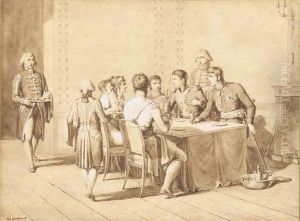Pierre-Rene Cacault Paintings
Pierre-René Cacault was a French diplomat, collector, and patron of the arts born in 1742 in Clamecy, Burgundy, France. Despite not being widely recognized as an artist himself, Cacault played a significant role in the artistic and cultural milieu of his time. He is perhaps best known for his contributions to the development of museums and his efforts in art collection.
Cacault's career as a diplomat was marked by his appointment as the French consul in Rome, where he served from 1787 to 1791. During his tenure, he developed strong connections with the local artistic community, which greatly influenced his taste and passion for art collection. His time in Italy was crucial for gathering a vast array of artworks, including paintings, sculptures, and antiquities.
Cacault's brother, François Cacault, was a notable collector and art dealer, and together, the brothers amassed a remarkable collection. Pierre-René's diplomatic position facilitated his acquisition of artworks and his ability to navigate the European art market. The Cacault brothers' collection became the foundation for the museum in their hometown of Clamecy, which was one of the first public museums in France, though it is more famously associated with the Musée d'Art et d'Histoire de Clisson, where much of their collection was eventually housed.
After the French Revolution, Pierre-René Cacault's role as a diplomat came to an end, and he returned to France. He focused on organizing his art collection and participating in the intellectual and cultural life of the post-revolutionary period. His contribution to the arts was not through creation but through his patronage, his discerning eye for collecting, and his role in making art more publicly accessible.
Pierre-René Cacault died in 1805. His legacy is closely tied to the early museum movement in France and the promotion of the arts during a time of great political and social change. The Cacault collection remains an important testament to his life's work and interest in preserving and sharing art with the public.
